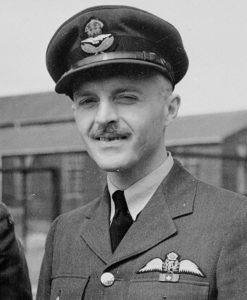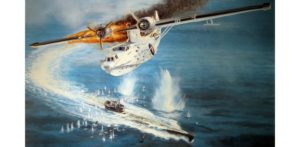International appeal launched for the RAF Wick Gate Guardian Memorial.
Wick Development Trust have launched an international campaign to try to help raise funds for the planned Gate Guardian and memorial for the entrance of Wick John O’ Groats Airport which was a former RAF Coastal Command Sector Station during the Second World War.
Of the 379 aircrews that died on operations flown out of RAF Wick between 1939 and 1945, 24 were from the Royal New Zealand Air Force (RNZAF) and 60 were from the Royal Canadian Air Force (RCAF).
Alistair Jack the Development Trust Officer for Caithness Voluntary Group who works with Wick Development Trust to help deliver their projects, reached out to both the RNZAF Association and the RCAF Association to see if they would be willing to support the memorial project.
The RNZAF Association has confirmed that they will support this very worthwhile project and will help promote the Wick Development Trusts Just Giving campaign in New Zealand.
The RCAF Association however has gone one step further and has created a standalone campaign within the RCAF Association Trust to help raise funds for the memorial which was emailed out to thousands of the association’s members.
Mr Jack commented, “We are very excited about this development in our project and would like to thank the Royal New Zealand Air Force Association and the Royal Canadian Air Force Association for their amazing support.”
“Whilst the main focus of the memorial has been around the story of Flight Lieutenant Alasdair Gunn and Spitfire AA810, there are many other events from RAF Wick that are just as amazing, and none more so than the story of David Hornell.”
In June 1944 David Hornell from Toronto in Canada was a Flight Lieutenant with No.162 Squadron RCAF and was flying Consolidated Canso amphibian aircraft from RAF Wick on Anti-Submarine Patrols over the North Atlantic.

 On the 24th of that month whilst on patrol near the Faroes, Flight Lieutenant Hornell’s aircraft was attacked and badly damaged by the German submarine U-1225.
On the 24th of that month whilst on patrol near the Faroes, Flight Lieutenant Hornell’s aircraft was attacked and badly damaged by the German submarine U-1225.
Despite the fact that the Starboard engine and wing was on fire and the petrol tanks were at risk of exploding, he and his crew pressed home their attack and managed to sink the submarine with depth charges.
The situation suddenly got worse when the starboard engine fell off and Flight Lieutenant Hornell had to fight with all his might to keep the aircraft under control. Through what was described by has crew as ‘superhuman efforts’ he managed to bring the burning aircraft down safely on the heavy swell.
The crew quickly abandoned the Canso before the entire aircraft was engulfed in flames, however only one small four man dinghy had survived which was not large enough to hold the eight man crew.
The crew had to take turns in the frigid waters of the North Atlantic, which claimed the lives of Sergeant Scott and Sergeant St. Laurent who had died during the night from hypothermia and were committed to the deep.
By the time the survivors were rescued 21 hours later, Flight Lieutenant Hornell was blind and weak from exposure and hypothermia and would tragically die five hours after being picked up. He is buried in Lerwick Cemetery on the Shetland Islands.
For his bravery Flight Lieutenant Hornell was awarded the Victoria Cross (Posthumously) which is Britains highest award for gallantry, and was the first member of the RCAF to be awarded the Victoria Cross, and one of only two RCAF members to earn this highest decoration for valour during the Second World War.
Flight Lieutenant Hornell VC is a national hero of Canada and as a legacy, the Toronto Island Airport ferry, The Junior school in Mimico, and a squadron of the Royal Canadian Air Cadets in Toronto are all named after him.
As well as this a Consolidated Canso in the collection of the Canadian Warplane Heritage Museum was restored in the colours and marking of 162 Squadron and dedicated to the memory of Flight Lieutenant David Hornell VC.
Victoria Cross Citation – For reference only
Flight Lieutenant Hornell was captain and first pilot of a twin-engined amphibian aircraft engaged on an anti-submarine patrol in northern waters. The patrol had lasted for some hours when a fully-surfaced U-boat was sighted, travelling at high speed on the port beam. Flight Lieutenant Hornell at once turned to the attack.
The U-boat altered course. The aircraft had been seen and there could be no surprise. The U-boat opened up with anti-aircraft fire which became increasingly fierce and accurate.
At a range of 1,200 yards, the front guns of the aircraft replied; then its starboard guns jammed, leaving only one gun effective. Hits were obtained on and around the conning-tower of the U-boat, but the aircraft was itself hit, two large holes appearing in the starboard wing.
Ignoring the enemy’s fire, Flight Lieutenant Hornell carefully manoeuvred for the attack. Oil was pouring from his starboard engine, which was, by this time, on fire, as was the starboard wing; and the petrol tanks were endangered. Meanwhile, the aircraft was hit again and again by the U-boat’s guns. Holed in many places, it was vibrating violently and very difficult to control.
Nevertheless, the captain decided to press home his attack, knowing that with every moment the chances of escape for him and his gallant crew would grow more slender. He brought his aircraft down very low and released his depth charges in a perfect straddle. The bows of the U-boat were lifted out of the water; it sank and the crew were seen in the sea.
Flight Lieutenant Hornell contrived, by superhuman efforts at the controls, to gain a little height. The fire in the starboard wing had grown more intense and the vibration had increased. Then the burning engine fell off. The plight of aircraft and crew was now desperate. With the utmost coolness, the captain took his aircraft into wind and, despite the manifold dangers, brought it safely down on the heavy swell. Badly damaged and blazing furiously, the aircraft rapidly settled.
After ordeal by fire came ordeal by water. There was only one serviceable dinghy and this could not hold all the crew. So they took turns in the water, holding on to the sides. Once, the dinghy capsized in the rough seas and was righted only with great difficulty. Two of the crew succumbed from exposure.
An airborne lifeboat was dropped to them but fell some 500 yards down wind. The men struggled vainly to reach it and Flight Lieutenant Hornell, who throughout had encouraged them by his cheerfulness and inspiring leadership, proposed to swim to it, through he was nearly exhausted. He was with difficulty restrained. The survivors were finally rescued after they had been in the water for 21 hours. By this time Flight Lieutenant Hornell was blinded and completely exhausted. He died shortly after being picked up.
Flight Lieutenant Hornell had completed 60 operational missions, involving 600 hours’ flying. He well knew the danger and difficulties attending attacks on submarines. By pressing home a skilful and successful attack against fierce opposition, with his aircraft in a precarious condition, and by fortifying and encouraging his comrades in the subsequent ordeal, this officer displayed valour and devotion to duty of the highest order
30th June 2022
In FY 2021/2022 trustees approved $553 worth of grants to the RAF Wick Gate Guardian.







